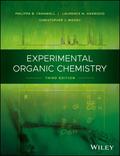Experimental Organic Chemistry

3. Auflage August 2017
688 Seiten, Softcover
Wiley & Sons Ltd
The definitive guide to the principles and practice of experimental organic chemistry - fully updated and now featuring more than 100 experiments
The latest edition of this popular guide to experimental organic chemistry takes students from their first day in the laboratory right through to complex research procedures. All sections have been updated to reflect new techniques, equipment and technologies, and the text has been revised with an even sharper focus on practical skills and procedures.
The first half of the book is devoted to safe laboratory practice as well as purification and analytical techniques; particularly spectroscopic analysis. The second half contains step-by-step experimental procedures, each one illustrating a basic principle, or important reaction type. Tried and tested over almost three decades, over 100 validated experiments are graded according to their complexity and all are chosen to highlight important chemical transformations and to teach key experimental skills.
New sections cover updated health and safety guidelines, additional spectroscopic techniques, electronic notebooks and record keeping, and techniques, such as semi-automated chromatography and enabling technologies such as the use of microwave and flow chemistry. New experiments include transition metal-catalysed cross-coupling, organocatalysis, asymmetric synthesis, flow chemistry, and microwave-assisted synthesis. Key aspects of this third edition include:
* Detailed descriptions of the correct use of common apparatus used in the organic laboratory
* Outlines of practical skills that all chemistry students must learn
* Highlights of aspects of health and safety in the laboratory, both in the first section and throughout the experimental procedures
* Four new sections reflecting advances in techniques and technologies, from electronic databases and information retrieval to semi-automated chromatography
* More than 100 validated experiments of graded complexity from introductory to research level
* A user-friendly experiment directory
* An instructor manual and PowerPoint slides of the figures in the book available on a companion website
A comprehensive guide to contemporary organic chemistry laboratory principles, procedures, protocols, tools and techniques, Experimental Organic Chemistry, Third Edition is both an essential laboratory textbook for students of chemistry at all levels, and a handy bench reference for experienced chemists.
Preface to the third edition xi
About the companion website xv
PART 1: LABORATORY PRACTICE 1
1 Safety in the chemical laboratory 3
1.1 Essential rules for laboratory safety 4
1.2 Hazardous chemicals 7
1.3 Disposal of hazardous waste 11
1.4 Accident procedures 12
2 Glassware and equipment in the laboratory 15
2.1 Glass equipment 16
2.2 Hardware 21
2.3 Heating 24
2.4 Stirring 30
2.5 Vacuum pumps 32
2.6 The rotary evaporator 42
2.7 Catalytic hydrogenation 46
2.8 Ozonolysis 48
2.9 Irradiation 50
2.10 Compressed gases 54
3 Organic reactions: From starting materials to pure organic product 61
3.1 Handling chemicals 62
3.2 The reaction 81
3.3 Purification of organic compounds 105
4 Qualitative analysis of organic compounds 185
4.1 Purity 185
4.2 Determination of structure using chemical methods 202
5 Spectroscopic analysis of organic compounds 207
5.1 Absorption spectroscopy 207
5.2 Infrared spectroscopy 209
5.3 Nuclear magnetic resonance spectroscopy 227
5.4 Ultraviolet spectroscopy 279
5.5 Mass spectrometry 295
6 Keeping records: The laboratory notebook and chemical literature 311
6.1 The laboratory notebook 312
6.2 The research report 322
6.3 The chemical literature 327
PART 2: EXPERIMENTAL PROCEDURES 329
Introduction 331
List of experiments 333
Experiments that can be taken in sequence 353
Experiments that can be used to compare directly different techniques for undertaking a reaction 354
Experiments that illustrate particular techniques 354
7 Functional group interconversions 355
7.1 Simple transformations 355
7.2 Reactions of alkenes 366
7.3 Substitution 386
7.4 Reduction 390
7.5 Oxidation 424
7.6 Rearrangements 436
8 Carbon-carbon bond?]forming reactions 443
8.1 Grignard and organolithium reagents 444
8.2 Enolate anions 456
8.3 Heteroatom?]stabilized carbanions 484
8.4 Aromatic electrophilic substitution 504
8.5 Pericyclic reactions 514
8.6 Metal?]mediated coupling reactions 534
9 Experiments using enabling technologies 545
9.1 Microwave chemistry 545
9.2 Flow chemistry 554
10 Projects 569
10.1 Natural product isolation and identification 569
10.2 Project in organic synthesis 578
10.3 Aspects of physical organic chemistry 608
APPENDICES 627
Organic solvents 629
Spectroscopic correlation tables 635
Index of chemicals 649
General index 657
Laurence M. Harwood, PhD is Professor of Organic Chemistry in the Department of Chemistry and Director of the Chemical Analysis Facility, University of Reading, UK.
Christopher J. Moody, PhD is Sir Jesse Boot Professor in the School of Chemistry, University of Nottingham, UK.


